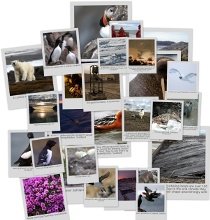Let ’em fly
The Arctic summer is a short event. From a bird-point-of-view this means that eggs are laid early June and chicks hatch in the both sides of the beginning of July. In the beginning of August most chicks have already fledged. New life develops from an egg into a self-sustaining creature during the three months of the summer on Svalbard. Those who did not manage to keep in the pace, died or will die as the autumn turns to winter. The speed the life takes, makes the summer to feel even shorter. Soon the sun goes down again and the summer is gone.
When chicks are ready to take off, adults will follow. In alcids juveniles tend to follow their fathers off to the sea to learn important hunting skills, while kittiwake chicks find themselves alone to form groups with other youngsters. Together they have to learn the rules needed to survive in the world, which gets tougher day by day as the autumn develops.
After the seabirds have left their colonies, seabird researchers have very few reasons to stay. Field season with birds has came to the end. For those in the high buildings of the city of Tromsø this means a work load with data in order to produce publications. For me it means a new kind of field work. Driving around to study chicks becomes to drive around chicks that are studying.






0 kommenttia:
Post a Comment